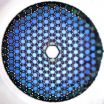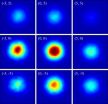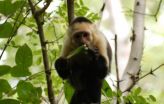(Press-News.org) This news release is available in German.
If you want to send light on a trip through optical fibres with as little loss as possible, you should opt for infrared light, as is the case, for example, in the telecommunication networks worldwide. For certain applications, such as spectroscopic investigations on ions or atoms, however, (laser) light in the ultraviolet range is required. But this type of light would quickly damage conventional optical fibres. Researchers from the Max Planck Institute for the Science of Light (MPL) in Erlangen/Germany and of the QUEST Institute, based at the Physikalisch-Technische Bundesanstalt (PTB), have tested a new type of optical fibre with a hollow core and have found out that this type of optical fibre was able to guide UV laser light without being damaged and with acceptable loss. Their investigations, which they have recently published in the journal "Optics Express", are interesting for numerous applications: besides precision spectroscopy on atoms or ions and their use in optical atomic clocks or quantum computers, fluorescence microscopy in biology, the investigation of process plasmas, combustion studies on soot or the spectroscopy of greenhouse gases would be other possible fields of application.
Optical fibres usually have a solid glass core. This glass core is coated with an optically thinner material. The laws of physics ensure that a light beam is kept inside such a fibre thanks to total reflection and that it can be transported over long distances without significant loss. Such optical fibres are therefore widely used worldwide to transport light of different spectral ranges – from the infrared up to the visible light range. UV light, however, has a shorter wavelength and is therefore strongly absorbed by the glass used in most types of optical fibres and the fibres are quickly damaged by UV light.
At the Max Planck Institute for the Science of Light (MPL) in Erlangen, experiments with other types of optical fibre have been carried out for a few years. Now, it has turned out that a certain type of optical fibre is particularly well-suited for UV light: a microstructured photonic crystal fibre (PCF) with a so-called "Kagome structure" – a special pattern consisting of triangles and of hexagons in a regular arrangement – and a hollow core of 20 µm in diameter. This core ensures a single-mode guiding of the light – i.e. with a spatial intensity distribution similar to the shape of a Gaussian bell-shaped curve. The crucial question was to know whether this transport was really single-mode and damage-free, and this is what the metrological experts from the QUEST Institute at PTB had to find out. Their investigations have shown that in the case of the UV beam used, with a wavelength of 280 nm, single-mode transmission was possible and that even after more than 100 hours in operation at a power of 15 mW, no UV-induced damage could be detected.
The optical fibres have even passed a first application test: the researchers at the QUEST Institute have used them successfully for their spectroscopic investigations on trapped ions. Stabilized by the new fibre, the UV laser beam allows an improved interrogation of the ions' internal state. Besides the users of such spectroscopic methods (for example in astronomy, chemistry or fundamental research in physics), this could also be useful for researchers who are developing quantum computers, since in that field, the internal states of a particle are the new digital 0s and 1s.
es/ptb
INFORMATION:
Contact at the Max Planck Institute for the Science of Light
Dr. Michael H. Frosz, Head of Fibre Fabrication, Max Planck Institute for the Science of Light, Günther-Scharowsky-Str. 1, 91058 Erlangen/Germany, Phone: +49 (0)9131 6877-321,
E-mail: michael.frosz@mpl.mpg.de, Internet: http://www.pcfibre.com
Contact at PTB
Prof. Dr. Piet O. Schmidt, QUEST Institute at PTB, Phone: +49 (0)531 592-4700,
E-mail: Piet.Schmidt@quantummetrology.de, Internet: http://www.quantummetrology.de/quest/eqm
Original publication
F. Gebert, M. H. Frosz, T. Weiss, Y. Wan, A. Ermolov, N. Y. Joly, P. O. Schmidt, and P. St. J. Russell:
Damage-free single-mode transmission of deep-UV light in hollow-core PCF. Optics Express 22, 15388 (2014)
Hollow optical fibers for UV light
New optical waveguides improve precision investigations in physics, chemistry and life sciences
2014-07-02
ELSE PRESS RELEASES FROM THIS DATE:
Inspired by nature, researchers create tougher metal materials
2014-07-02
Drawing inspiration from the structure of bones and bamboo, researchers have found that by gradually changing the internal structure of metals they can make stronger, tougher materials that can be customized for a wide variety of applications – from body armor to automobile parts.
"If you looked at metal under a microscope you'd see that it is composed of millions of closely-packed grains," says Yuntian Zhu, a professor of materials science and engineering at NC State and senior author of two papers on the new work. "The size and disposition of those grains affect the ...
Behavioral therapy in pediatric antidepressant treatment reduces likelihood of relapse
2014-07-02
DALLAS – July 2, 2014 – Cognitive behavioral therapy in addition to medication improves the long-term success of treatment for children and adolescents suffering from depression, a new UT Southwestern Medical Center study indicates.
Based on the results of a clinical trial conducted at UT Southwestern and Children's Medical Center of Dallas, depression relapse rates were substantially lower in a group of youth who received both forms of treatment versus medication alone.
"Continuation-phase strategies designed to reduce the high rates of relapse in depressed youths ...
Harnessing a personal rivalry can boost an individual's athletic performance
2014-07-02
July 2, 2014 - We can all think of great sports rivals: tennis players Andre Agassi and Pete Sampras, swimmers Michael Phelps and Ryan Lochte, or basketball players Magic Johnson and Larry Bird. These fierce, personal rivalries seem worlds apart from a hometown 5K race. Yet even local races often produce rivals who push each other to higher levels of performance, according to new research that surveyed runners and used data from 184 races.
Rivalries are distinct from other competitions as those involved place higher stakes on their performance independent of any tangible ...
Twin study links community socioeconomic deprivation to sleep duration
2014-07-02
DARIEN, IL – A new study of adult twins suggests that the level of socioeconomic deprivation in a neighborhood is associated with the sleep duration of residents.
Results show that increased socioeconomic deprivation was significantly associated with decreased sleep duration across all twins. Further analysis within twin pairs found that this association remained significant after accounting for genetics and shared family environment, indicating a robust relationship.
"These results are a starting point for discussing the impact that neighborhood-level factors have ...
The dark side of Twitter -- Infidelity, break-ups, and divorce
2014-07-02
New Rochelle, NY, July 2, 2014—With more than 554 million active users, Twitter is one of the most popular social networking sites. Active users of social networking who are in a romantic relationship may find that Twitter-related conflicts cause relationship problems that can become serious enough to result in infidelity or divorce, as described in a study published in Cyberpsychology, Behavior, and Social Networking , a peer-reviewed journal from Mary Ann Liebert, Inc., publishers. The article is available free on the Cyberpsychology, Behavior, and Social Networking ...
Causes of serious pain syndrome closer to discovery
2014-07-02
Researchers at the University of Liverpool have taken a major step forward in understanding the causes of a disorder which causes chronic pain in sufferers.
Complex Regional Pain Syndrome (CRPS) is a serious condition affecting a limb after an – often small – accident or operation. It can cause severe pain lasting many years, as well as limb swelling, hair and nail growth changes, and muscle atrophy, but until now there has been no clear evidence of the cause.
Now the research team from the University's Institute of Translational Medicine alongside colleagues at the ...
Upending a cancer dogma
2014-07-02
Researchers at the University of California, San Diego School of Medicine say a protein essential to regulating cell cycle progression – the process of cell division and replication – activates a key tumor suppressor, rather than inactivating it as previously thought.
"The finding is the result of literally 20 years of work in my lab," said Steven F. Dowdy, PhD, professor in the Department of Cellular and Molecular Medicine at UC San Diego. "It completely turns upside-down what was thought to be a fundamental aspect of cell cycle progression in all cancer cells driven ...
Deforestation remedies can have unintended consequences, UF researchers say
2014-07-02
GAINESVILLE, Fla. --- When it comes to fixing deforestation and forest degradation, good intentions can lead to bad outcomes.
That's the take-away from a new study by two University of Florida researchers who say efforts to restore damaged and destroyed tropical forests can go awry if the people making the plans of action don't choose wisely.
"We need to be careful about what is it we're losing and gaining," UF biology professor Francis E. "Jack" Putz said. Putz worked with UF biology professor Claudia Romero on the paper, which will appear in the July issue of Biotropica. ...
Antibiotic therapy reduces mortality by 68 percent in hemodialysis patients
2014-07-02
DETROIT – An antibiotic therapy known to reduce catheter-related bloodstream infections in hemodialysis patients has been shown for the first time to reduce mortality, according to a Henry Ford Health System study.
Researchers found that a low-dose "lock" solution of gentamicin/citrate reduced mortality by 68 percent compared to a solution of heparin, a blood-clotting therapy long considered the standard of care. Additionally, the gentamicin/citrate solution was associated with a 73 percent reduction in bloodstream infections compared to the heparin treatment.
Bloodstream ...
Insect diet helped early humans build bigger brains, study suggests
2014-07-02
Figuring out how to survive on a lean-season diet of hard-to-reach ants, slugs and other bugs may have spurred the development of bigger brains and higher-level cognitive functions in the ancestors of humans and other primates, suggests research from Washington University in St. Louis.
"Challenges associated with finding food have long been recognized as important in shaping evolution of the brain and cognition in primates, including humans," said Amanda D. Melin, PhD, assistant professor of anthropology in Arts & Sciences and lead author of the study.
"Our work suggests ...
LAST 30 PRESS RELEASES:
Norbert Holtkamp appointed director of Fermi National Accelerator Laboratory
New agentic AI platform accelerates advanced optics design
Biologists discover neurons use physical signals — not electricity — to stabilize communication
Researchers discover that a hormone can access the brain by hitchhiking
University of Oklahoma researcher awarded funding to pursue AI-powered material design
Exploring how the visual system recovers following injury
Support for parents with infants at pediatric check-ups leads to better reading and math skills in elementary school
Kids’ behavioral health is a growing share of family health costs
Day & night: Cancer disrupts the brain’s natural rhythm
COVID-19 vaccination significantly reduces risk to pregnant women and baby
The role of vaccination in maternal and perinatal outcomes associated with COVID-19 in pregnancy
Mayo Clinic smartwatch system helps parents shorten and defuse children's severe tantrums early
Behavioral health spending spikes to 40% of all children’s health expenditures, nearly doubling in a decade
Digital cognitive behavioral treatment for generalized anxiety disorder
Expenditures for pediatric behavioral health care over time and estimated family financial burden
Air conditioning in nursing homes and mortality during extreme heat
The Alps to lose a record number of glaciers in the next decade
What makes a good proton conductor?
New science reporting guide published for journalists in Bulgaria
New international study reveals major survival gaps among children with cancer
New science reporting guide published for journalists in Turkey
Scientists develop a smarter mRNA therapy that knows which cells to target
Neuroanatomy-informed brain–machine hybrid intelligence for robust acoustic target detection
Eight SwRI hydrogen projects funded by ENERGYWERX
The Lundquist Institute and its start-up company Vitalex Biosciences Announces Strategic Advancement of Second-Generation fungal Vaccine VXV-01 through Phase 1 Trials under $40 Million Competitive Con
Fine particles in pollution are associated with early signs of autoimmune disease
Review article | Towards a Global Ground-Based Earth Observatory (GGBEO): Leveraging existing systems and networks
Penn and UMich create world’s smallest programmable, autonomous robots
Cleveland researchers launch first major study to address ‘hidden performance killer’ in athletes
To connect across politics, try saying what you oppose
[Press-News.org] Hollow optical fibers for UV lightNew optical waveguides improve precision investigations in physics, chemistry and life sciences







